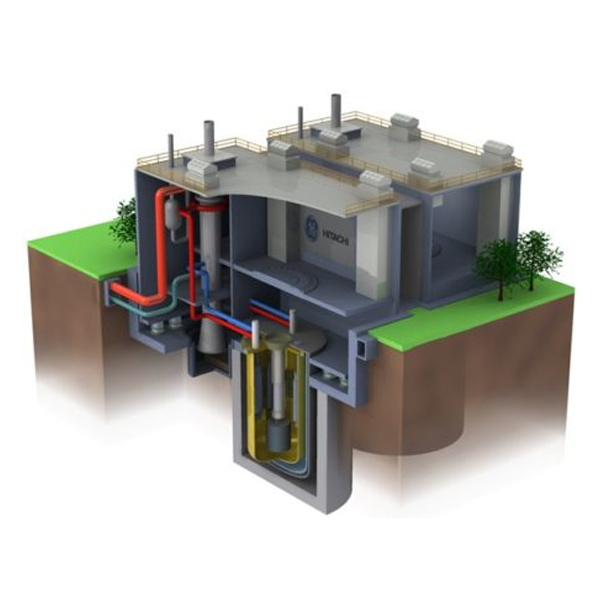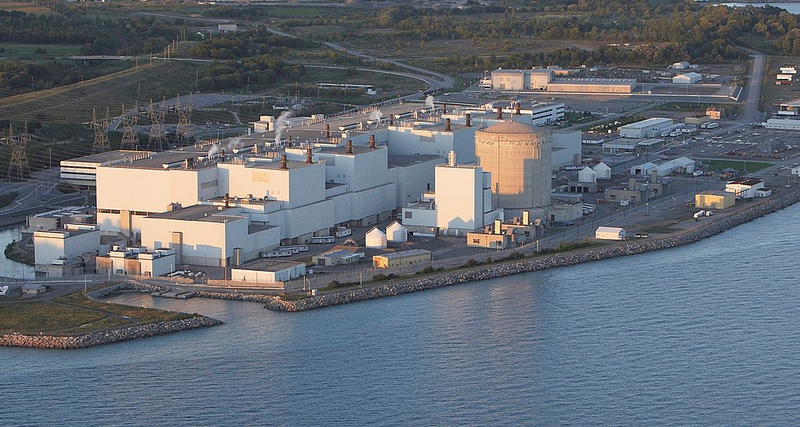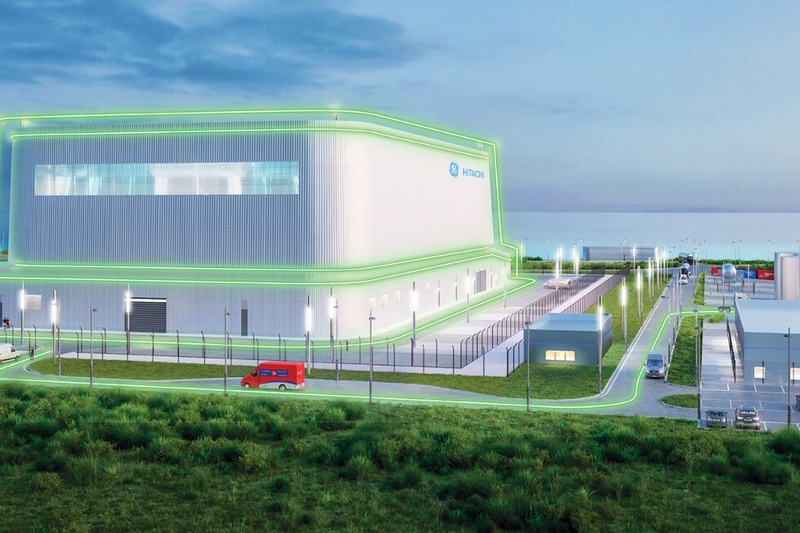
Redefining Energy with Small Modular Reactors

General Electric-Hitachi Power Reactor Innovative Small Module (U.S. Nuclear Regulatory Commission)

General Electric-Hitachi Power Reactor Innovative Small Module (U.S. Nuclear Regulatory Commission)
How does this align with my curriculum?
Learn about small modular reactor technology and its future in Canada.
Introduction
What do you picture when you think of a nuclear reactor? Is it a HUGE piece of technology that uses the power of atoms to generate electricity? There are many nuclear reactors in Canada. They operate at facilities like the Bruce Nuclear Generating Stations and Ontario Power Generation Stations (Pickering and Darlington) in Ontario and the Point Lepreau Nuclear Generating Station in New Brunswick. Nuclear reactors are an important part of generating a lot of electricity with low carbon emissions.
A nuclear facility usually includes reactor buildings, turbines, cooling towers, and other structures. The size of a nuclear power plant depends on the number and sizes of its reactors. A traditional nuclear power plant can cover several square kilometres of land. It can also be several stories tall.
Image - Text Version
Shown is a colour photograph of the buildings that make up the Darlington nuclear power facility on the shore of Lake Ontario. Near the shore is a tall, round, concrete tower with a domed top. In front of it is a tall, narrow, white, windowless building. Behind these is a row of large, white blocky buildings, also windowless. Behind them is a row of power transmission towers. All of these are surrounded by parking lots and dozens of small, one story buildings in different shapes. Curving roads lead away from the area, through a leafy green landscape.
But what if we could make nuclear reactors smaller? This is just what engineers around the world are working on.
What is a Small Modular Reactor?
Small modular reactors (SMRs) are a new kind of nuclear reactor. SMRs are like mini nuclear power plants with new features and designs. They are designed to be safer and take up less space than a traditional reactor.
SMRs work in a similar way to a traditional nuclear reactor. They use fission to take the energy from splitting atoms to make heat. That heat is then used to generate electricity.
What's a Small Modular Rector? (0:47) from the Canadian Nuclear Safety Commission
Types of SMRs
SMRs come in various sizes, designs and power levels. This means they can be used to power different things. These include buildings, neighbourhoods or even entire communities.
SMRs using several different technologies are being developed in Canada. These include:
Molten Salt Reactor
Molten salt is salt that is solid at room temperature and liquid at higher temperatures. This can be used both to fuel and to cool the reactor. Traditional nuclear reactors use solid uranium for fuel and water for cooling.
Sodium-cooled Fast Reactor
This type of reactor uses liquid metal instead of water for cooling. In sodium-cooled reactors, the metal is sodium.
High-temperature Gas-cooled Reactor
These reactors use solid uranium for fuel. But instead of water, they use helium for cooling.
How small is small?
Small modular reactors come in many different sizes. They can be as small as a shipping container or as big as a whole city block! Check out the video below for more information.
How small are Small Modular Reactors? (1:03) from the Canadian Nuclear Safety Commission
How much power do SMRs produce?
The power an SMR can generate depends on the size and design. Today, an SMR can generate up to 300 megawatts of electricity. These can be part of the energy mix for larger communities.
Image - Text Version
Shown are colour illustrations of three different nuclear reactors in landscapes.
The left image shows two tall, round, grey towers with wide bases and walls that curve in and back out. The third building is a smaller, darker, cylindrical tower with a domed top, about half the size of the others. There are two trees in the foreground and the Sun shines overhead. This is labelled “Large, conventional reactor: 700+ MW(e).”
The centre image shows the same two trees on the left in the foreground, and another on the right. The buildings here are the same height as the tallest tree. This is less than half the size of the large towers in the previous image. They are a mix of dark grey cylinder and cube shapes. Rolling hills are visible behind the buildings, and there are birds and fluffy white clouds in the sky above. This is labelled “Small modular reactor: Up to 300 MW(e).”
The right image shows an even smaller grey building with trees on either side. This reactor is about half the size of the largest tree. A transport truck in the background shows it is also about half the height and width of that. The hill in the background towers over this reactor. It is topped with coniferous trees, and there are fluffy white clouds in the sky above. This is labelled “Microreactor: Up to ~10 MW(e).”
There are also very small SMRs that generate between 2 to 30 megawatts of power. SMRs that generate less than 10 megawatts of power are called microreactors. These are ideal in situations with very limited space. Or where a smaller amount of power is needed.
What are the benefits of SMRs?
SMRs can bring clean energy to a variety of locations and situations. They do not need a lot of space and they can be easy to transport. This makes SMRs an ideal choice for rural and remote communities. These communities may not be connected to the electricity grid.
Like all nuclear reactors, SMRs do not produce greenhouse gases when they are running. SMRs can be a cleaner replacement for diesel generators. These are machines that use diesel fuel to generate electricity. Diesel generators currently supply electricity in many remote communities.
Did you know?
You can use the Remote Communities Energy Database to see what kind of energy powers some communities across Canada.
Traditional nuclear reactors generate a lot of electricity. This is why they are usually found in regions with large cities. Other parts of Canada need less electricity. SMRs can help in these areas because they can be built to meet a region’s specific energy needs.
Large facilities like pulp and paper mills and oil refineries often need their own sources of energy. SMRs can supply the on-site power and heat they need.
SMRs in Canada
Canadian provinces are beginning to explore SMRs as a way of generating electricity. The government of Canada has created the SMR Roadmap and the SMR Action Plan to guide this development in the coming years.
Four SMR projects are currently in development. These are:
- Global First Power
- NB Power’s ARC-100 Project
- OPG’s Darlington New Nuclear Project
- SaskPower’s proposed SMR project
Image - Text Version
Shown is a colour illustration of the planned SMR plant at OPGs Darlington nuclear facility on the shore of Lake Ontario.
The building looks four or five stories tall and is covered with corrugated white cladding. It has one long window near the top of the closest wall, and there are several loading dock doors at ground level. The GE logo and the Hitachi logo are mounted on the right wall. The building is surrounded by two chain link fences and lights on poles, similar to streetlights. There is a second small, square, blue building near the right corner. The whole, large building is outlined in glowing green lines that look like neon lights. One green line leads into the parking lot on the right, where there are two smaller buildings. Several vehicles, including a Canada Post truck, drive along a road that leads from there, around the building. The water in the background is pale greyish blue, and the hill in the foreground is lush and green.
Regulating and Licencing SMRs
The SMR Action Plan includes the rules and regulations around new nuclear technologies. The Canadian Nuclear Safety Commission (CNSC) regulates and licences all nuclear facilities and activities in Canada.
The CNSC also oversees the management of radioactive waste. Managing waste safely is a crucial part of making sure SMR projects are safe.
When deciding whether to licence an SMR project, the CNSC listens to different people involved. These include the public, the companies, and Indigenous Nations and communities. Everyone is encouraged to share their thoughts. And there is funding available to help people take part in these discussions. It's important for as many people as possible to be part of the decision-making process.
Careers in Nuclear Energy
Working in nuclear energy is all about helping provide clean and efficient power. There are many different careers in this field.
- Nuclear engineers design and run nuclear reactors to make sure they work safely and well
- Nuclear physicists do research to make nuclear technology even better
- Radiation protection specialists keep an eye on radiation levels to keep everyone safe
There are also careers in areas related to nuclear energy. These include creating laws and policies to protect the environment, regulating nuclear energy, and managing power plants. Jobs in nuclear energy are important for the future of clean power. It's a great field for people who like science and engineering, and care about the environment.
Meet some of the CNSC experts who support and contribute to Canada’s SMR readiness.
Here are some real people who have jobs in nuclear energy:
Let’s Talk Science appreciates the contributions of the Canadian Nuclear Safety Commission in the development of this backgrounder.
Learn More
CNSC Experts
On this page by the Canadian Nuclear Safety Commission, you’ll learn about some of the people who work at the CNSC and the important work they do.
What is radioactive waste? (2023)
This video (2:50 min) from the Canadian Nuclear Safety Commission explains what radioactive waste is, where it comes from and how we dispose of it in Canada.
Generating Electricity: Nuclear Energy
This article from Let’s Talk Science explores how nuclear energy is generated and how it is used in Canada.
References
Canada. (Aug 31, 2023). About small modular reactors. Canadian Nuclear Safety Commission.
Canada. (Aug 31, 2023). Small modular reactors. Canadian Nuclear Safety Commission.
Canada. (Aug 31, 2023). Licensing, regulation and public hearings. Canadian Nuclear Safety Commission.
Canada. (Aug 31, 2023). SMR Facilities. Canadian Nuclear Safety Commission.
Electricity Canada. (n.d.) The Grid.
Liou, J. (Sept 13, 2023). What are Small Modular Reactors (SMRs)? International Atomic Energy Agency.
Ontario Power Generation (2023). Small modular reactors.
U.S. Department of Energy. (n.d.) Advanced Small Modular Reactors (SMRs). Office of Nuclear Energy.






